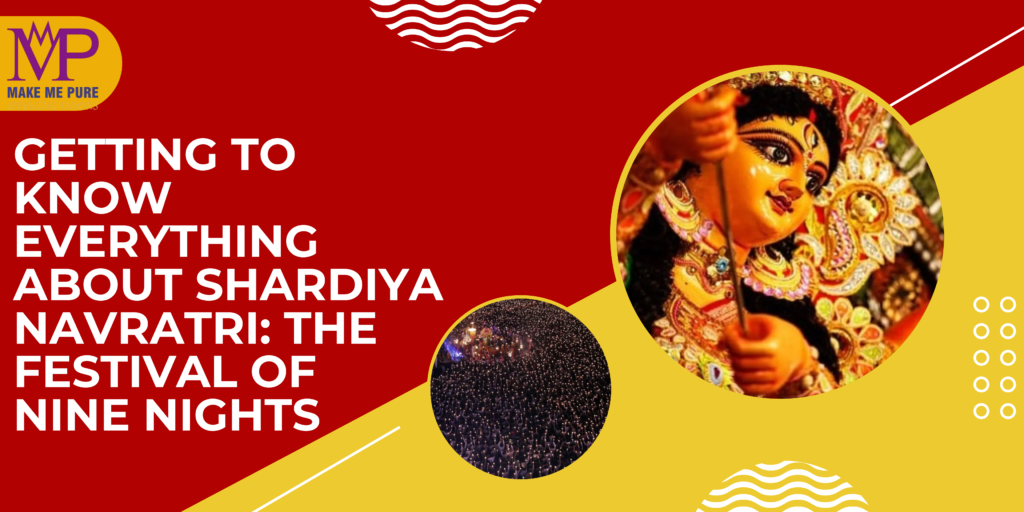
Getting to Know Everything about Shardiya Navratri: The Festival of 9 Nights
Shardiya Navratri, one of the most significant Hindu festivals, is celebrated with immense devotion and enthusiasm across India. The festival, dedicated to Goddess Durga and her nine manifestations, spans nine nights and ten days. It typically falls in the month of Ashwin (September-October) according to the Hindu lunar calendar. “Shardiya” refers to the Sharad season (autumn), and hence this Navratri is observed during this period, marking the victory of good over evil. Each day is devoted to a different form of the goddess, making this festival deeply spiritual and symbolic.
The Significance of Shardiya Navratri
Shardiya Navratri holds immense religious importance. It is believed that during this period, the divine energy of Goddess Durga descends upon Earth, and she blesses her devotees with prosperity, happiness, and protection from evil. The festival is a reminder of the feminine divine energy (Shakti) that nurtures, protects, and empowers the universe.
Navratri also symbolizes the victory of light over darkness and good over evil. According to Hindu mythology, it commemorates Goddess Durga’s triumph over the buffalo demon Mahishasura, who represented negative forces. Thus, the festival is an expression of gratitude to the goddess for restoring balance and dharma (righteousness) in the world.
The Nine Forms of Goddess Durga
Each day of Navratri is dedicated to one of the nine forms (Navadurga) of Goddess Durga. These nine goddesses are worshiped in a specific sequence, and each one represents a different aspect of the goddess’s power and virtues.
1. Day 1 – Shailaputri: The daughter of the mountains, Shailaputri is the first manifestation of Goddess Durga. She represents purity and strength.
2. Day 2 – Brahmacharini: This form signifies the goddess’s penance and devotion. She symbolizes spiritual wisdom and loyalty.
3. Day 3 – Chandraghanta: Known for her fierce form, Chandraghanta is a symbol of courage and bravery, protecting her devotees from harm.
4. Day 4 – Kushmanda: This form represents the creation of the universe. She is said to have created the cosmos with her divine smile.
5. Day 5 – Skandamata: As the mother of Lord Kartikeya (Skanda), she embodies the strength of a mother and the nurturing aspect of the divine feminine.
6. Day 6 – Katyayani: She is the warrior goddess who vanquished the demon Mahishasura, symbolizing the fierce and protective nature of Durga.
7. Day 7 – Kalaratri: The fiercest form of Durga, Kalaratri destroys all evil and negativity, signifying the end of darkness and ignorance.
8. Day 8 – Mahagauri: This form represents purity and serenity, bringing peace and calmness into the lives of her devotees.
9. Day 9 – Siddhidatri: She is the granter of wisdom and spiritual enlightenment, bestowing divine knowledge and fulfillment to her devotees.

Rituals and Customs of Shardiya Navratri
During Shardiya Navratri, various rituals are performed, with each region having its unique customs and traditions. The common thread, however, is the deep devotion and reverence for the goddess.
1. Kalash Sthapana (Ghatasthapana): Navratri begins with the ritual of Kalash Sthapana, symbolizing the invocation of Goddess Durga. A pot (kalash) filled with water is placed on a clean area of the house or temple, and it is decorated with mango leaves and a coconut on top. This represents the goddess’s presence in the home.
2. Fasting: Many devotees observe fasts during Navratri, either for all nine days or on selective days. The fasting rules may vary, but common food items include fruits, dairy products, and special grains like buckwheat (kuttu) and amaranth (rajgira). The fast is seen as a means to purify the mind and body, allowing devotees to focus on their spiritual practices.
3. Garba and Dandiya: In Gujarat and parts of western India, Navratri is synonymous with the vibrant dance forms of Garba and Dandiya. These dances are performed in circles, symbolizing the cycle of life and the eternal presence of the goddess. People dress in traditional attire and celebrate each night with music, dance, and prayers.
4. Kanya Pujan: On the eighth or ninth day of Navratri, devotees perform Kanya Pujan, where young girls (symbolizing the goddess) are invited to their homes, worshiped, and fed delicious food. This is a symbolic gesture of worshiping the divine feminine in its purest form.
5. Durga Puja: In West Bengal and other eastern states, Navratri culminates in Durga Puja, a grand celebration marked by elaborate pandals (temporary structures) housing beautifully crafted idols of Goddess Durga. The final day, Vijayadashami (also known as Dussehra), marks the immersion of the idols, signifying the goddess’s return to her celestial abode.
Vijayadashami (Dussehra)
The tenth day of Shardiya Navratri, known as Vijayadashami or Dussehra, holds great significance. It marks the victory of Lord Rama over the demon king Ravana, symbolizing the triumph of good over evil. Huge effigies of Ravana, his brother Kumbhakarna, and son Meghnad are burnt in various parts of India, symbolizing the destruction of evil. It is also considered an auspicious day to begin new ventures and seek blessings for success and prosperity.
The Spiritual Essence of Navratri
Beyond the rituals and festivities, Shardiya Navratri holds a deep spiritual meaning. It is a time of inner reflection and renewal. The nine days represent a journey from ignorance to knowledge, from darkness to light. By worshiping the goddess in her various forms, devotees seek to purify their hearts and minds, remove obstacles, and awaken the divine energy within themselves.
Navratri also emphasizes the importance of the feminine divine power (Shakti) in the universe. It celebrates the idea that creation, protection, and destruction are all manifestations of this energy, and by tapping into it, one can attain wisdom, strength, and spiritual fulfillment.
Tags:
Post Categories
- All Post (12)
- Services (20)
- Astrology (15)
- Past Life Regression (20)
- Money Reiki (15)
- Mid Brain Activation (08)
